MICROSCOPE SLIDE MOUNTING KIT
MODEL: 'MOUNTING CABINET'
Date: after 1878.
DESCRIPTION
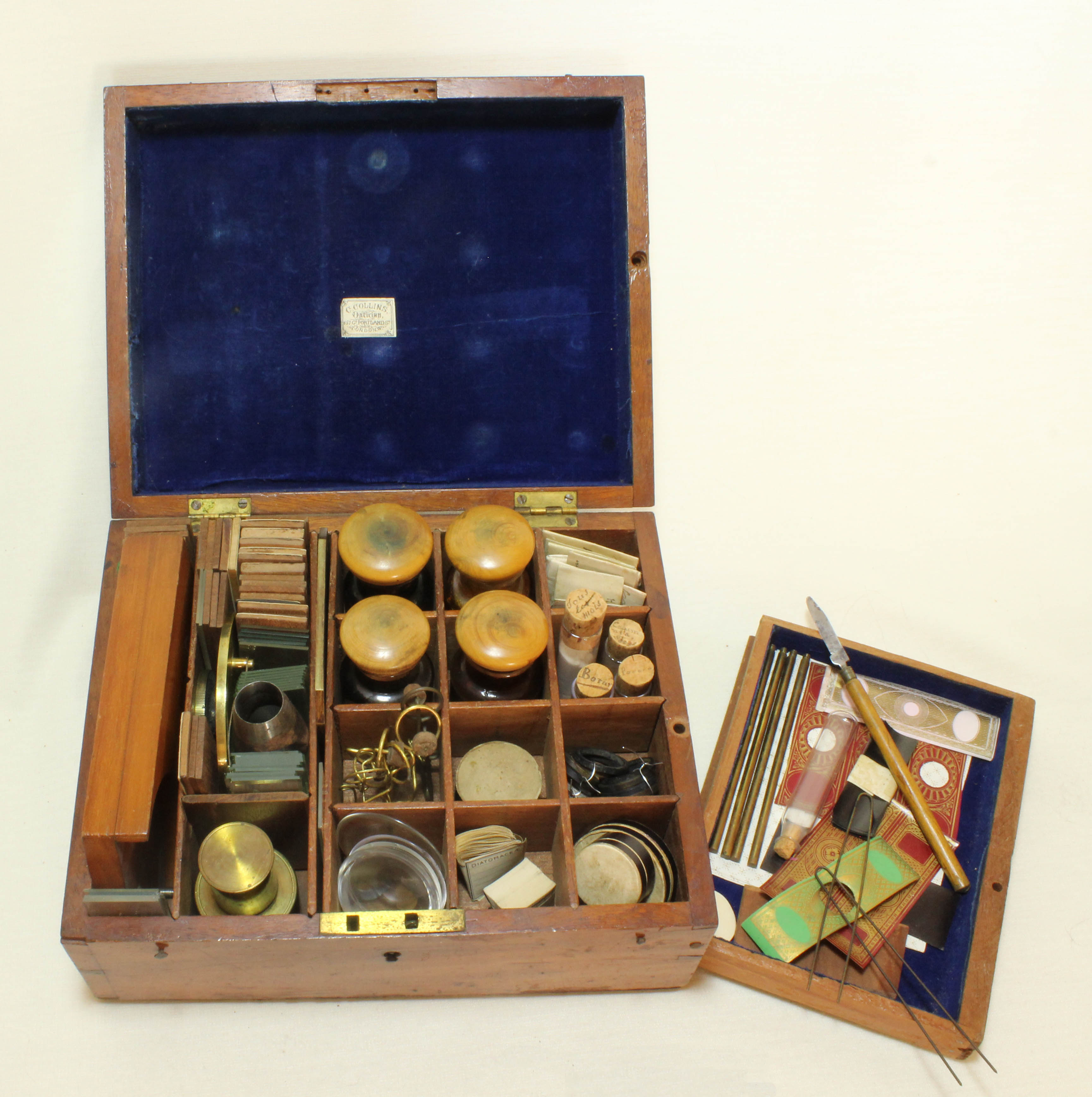
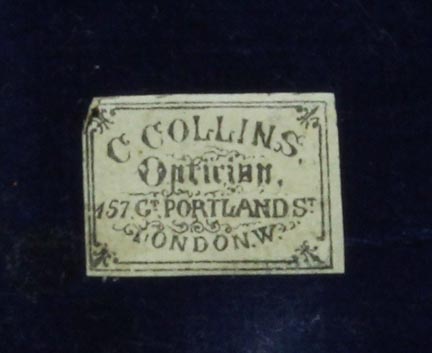 This 'mounting cabinet' is made of
pine. The top lid is lined with blue velour and bears the small trade
label of 'Collins, Optician, 157 Gt PORTLAND ST, LONDON N.W.'
The contents are stored not only under the top lid, but also
in a drawer which slides out to the right side. This drawer is secured
by a pin from above and the drawer is held against the pin by some
tension imparted by some pieces of bent spring steel inside its
compartment. To release the drawer, one needs to push it inwards,
releasing some of the tension and allowing the pin to be withdrawn.
This 'mounting cabinet' is made of
pine. The top lid is lined with blue velour and bears the small trade
label of 'Collins, Optician, 157 Gt PORTLAND ST, LONDON N.W.'
The contents are stored not only under the top lid, but also
in a drawer which slides out to the right side. This drawer is secured
by a pin from above and the drawer is held against the pin by some
tension imparted by some pieces of bent spring steel inside its
compartment. To release the drawer, one needs to push it inwards,
releasing some of the tension and allowing the pin to be withdrawn.
The compartments are adjustable in that the dividers can be
added or removed at will, not unlike the plastic utility boxes of
today. The two columns of compartments to the left side are deeper than
the the other three columns, which of course sit above the drawer.
The kit features a good complement of accessories for the microscopist
to make a variety of mounts, not only on slides but also on little
pinned pieces of cork. It provides a variety of adhesives as well a
Canada Balsam as a mountant. With the kit are a variety of unmounted
specimens both in little pieces of folded paper, and in cork-stoppered
vials. The contents are as follows:
- Four original Collins Reagent bottles including Canada
Balsam, Marine Glue, 'Asphalte', and Gold size.
- A large assortment of 'Cells' of various heights and
diameters
- Plain glass slides ('Glass Slips')
- Cork Mounts, with black paper cover on one side and white
on the other; one is labeled 'Arrow Root' but no longer contains a
specimen
- Wooden Slides of Mahogany with various sizes of openings,
some with black bottoms in the openings, some unchanged. Some of these
slides are of the size to accept the Cork Mounts. They have white paper
backing.
- Round and also Square cover slips ('thin glass') in small
circular white cardboard containers with either red or pink lining
- A variety of unused Slide Cover Papers including a group
for smaller than usual slides. There is also some Uncut Decorated
Paper.
- Two packs of Slide Labels
- There is a Scalpel, Dissecting Needle, and a delicate Brass
Forceps. The Scalpel and Needle have wooden handles with metal ferules.
- Eight paper packages of Unmounted Specimens
- Four cork-stoppered Vials of Specimens
- Brass Cover-Slip Clamps ('Brass Clips')most with a cork tip
on the clamping surface
- Six Watch Glasses ('Glass Saucers')
- A pine and Brass Ringing ('Revolving') Table
- A slotted Brass Slide-Warming Table with detachable brass
legs
- A miniature brass 'Spirit Lamp' for heating the table
- A heavy punch for cutting round pieces of paper or other
material to fit under the cells or for labels
- Two long bent wires with sharp tips
The kit and its contents fit very well the description given
in Collins catalogs. A further description and details of the
individual items follows.
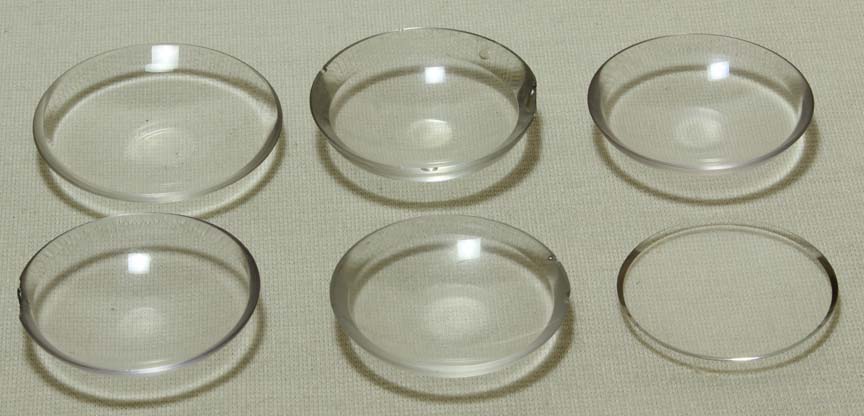 Before
selecting a specimen for mounting (from pond water for example), small
portions of the source could be examined grossly on these
'watchglasses,' which Collins referred to as 'glass saucers.'
They came in a variety of sizes and depths and some had a
small portion of the bottom flattened to steady them on a table.
Before
selecting a specimen for mounting (from pond water for example), small
portions of the source could be examined grossly on these
'watchglasses,' which Collins referred to as 'glass saucers.'
They came in a variety of sizes and depths and some had a
small portion of the bottom flattened to steady them on a table.
 The four bottles of
reagents, all with original Collins labels have wood-topped cork
stoppers. Canada Balsam, one of the best mountants of all time was of
course included. 'Asphalte' is a tar-like substance which was used for
sealing specimens under a coverslip and especially specimens in deep
cells and was used for 'ringing' the cell, a process facilitated by the
Ringing table. Goldsize is a material of a lighter color, used for the
same purpose as Asphalt, but being of lighter color could be used alone
or mixed with dies to impart color to the ring. Marine Glue, as its
name implies, is a water insoluble cement used for gluing a ring to a
slide and the coverslip to the ring. This glue will dry even in a moist
environment, allowing cells to contain liquid preservatives. Gold size
is another adhesive. (The author is grateful to James Solliday for the
information contained in this paragraph).
The four bottles of
reagents, all with original Collins labels have wood-topped cork
stoppers. Canada Balsam, one of the best mountants of all time was of
course included. 'Asphalte' is a tar-like substance which was used for
sealing specimens under a coverslip and especially specimens in deep
cells and was used for 'ringing' the cell, a process facilitated by the
Ringing table. Goldsize is a material of a lighter color, used for the
same purpose as Asphalt, but being of lighter color could be used alone
or mixed with dies to impart color to the ring. Marine Glue, as its
name implies, is a water insoluble cement used for gluing a ring to a
slide and the coverslip to the ring. This glue will dry even in a moist
environment, allowing cells to contain liquid preservatives. Gold size
is another adhesive. (The author is grateful to James Solliday for the
information contained in this paragraph).
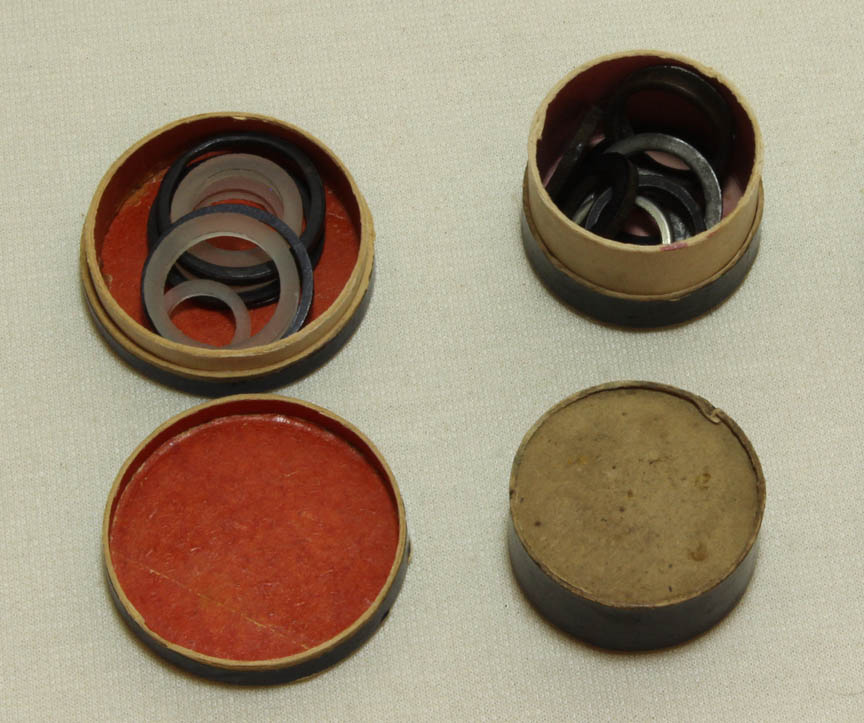 A variety of sizes and depths of
'cells' were supplied with the kit. This allowed great flexibility in
mounting and protecting three dimensional specimens. They were made of
hard rubber, metal, and glass.
A variety of sizes and depths of
'cells' were supplied with the kit. This allowed great flexibility in
mounting and protecting three dimensional specimens. They were made of
hard rubber, metal, and glass.
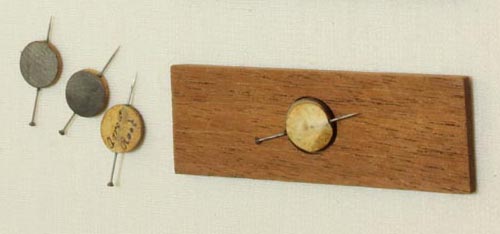 Cork mounts were sometimes used to
hold opaque objects, especially three dimensional ones that did not
require sealing to protect them from the elements. Examples might
include small shells, minerals, and some crystals. These cork mounts
usually had a pin going through them. The specimen was mounted on one
side, with either a white or black background, the obverse often
labeled. These specimens could be stored one next to another, pinned to
a board. When examined, they fit inside a depression in a wooden slide,
This arrangement saved supplies and also space. The specimen could be
tilted on a special tilting superstage, to view its various three
dimensional characteristics. The big disadvantage was that the subject
was easily dislodged; many, if not most of the surviving examples have
lost their objects.
Cork mounts were sometimes used to
hold opaque objects, especially three dimensional ones that did not
require sealing to protect them from the elements. Examples might
include small shells, minerals, and some crystals. These cork mounts
usually had a pin going through them. The specimen was mounted on one
side, with either a white or black background, the obverse often
labeled. These specimens could be stored one next to another, pinned to
a board. When examined, they fit inside a depression in a wooden slide,
This arrangement saved supplies and also space. The specimen could be
tilted on a special tilting superstage, to view its various three
dimensional characteristics. The big disadvantage was that the subject
was easily dislodged; many, if not most of the surviving examples have
lost their objects.
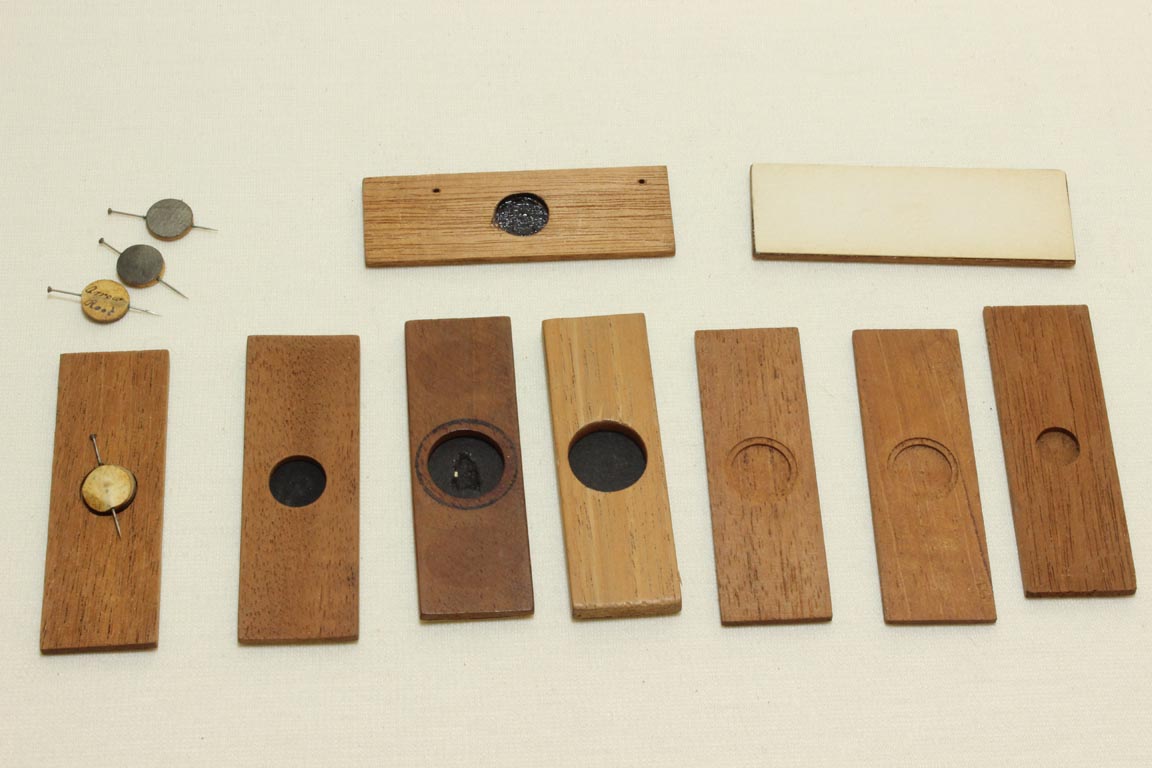
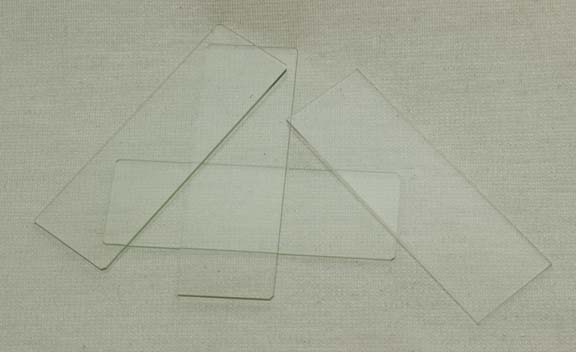 According to the catalog, the kit
was supplied with standard (1 x 3 inch) glass slides and also wooden
ones. The glass slides of this period in history usually had polished
edges. Those of the early twentieth century actually took a step
backward and were often sold without polished edges. The wooden slides
supplied with this kit are also of standard size, and have round
cavities of various depths and diameters. They could be used to hold
cork mounts, or, with a suitable base layer of black or white paper,
solid objects of their own. These slides are made of mahogany.
According to the catalog, the kit
was supplied with standard (1 x 3 inch) glass slides and also wooden
ones. The glass slides of this period in history usually had polished
edges. Those of the early twentieth century actually took a step
backward and were often sold without polished edges. The wooden slides
supplied with this kit are also of standard size, and have round
cavities of various depths and diameters. They could be used to hold
cork mounts, or, with a suitable base layer of black or white paper,
solid objects of their own. These slides are made of mahogany.
 According
to the catalog both round and square cover slips were supplied with
this kit. At that time in history (2nd half of 19th C), these were
usually supplied in little round cardboard boxes, usually with black
sides and white tops; sometimes the tops were labeled. The inside of
the boxes of this period were usually colored pink or red.
According
to the catalog both round and square cover slips were supplied with
this kit. At that time in history (2nd half of 19th C), these were
usually supplied in little round cardboard boxes, usually with black
sides and white tops; sometimes the tops were labeled. The inside of
the boxes of this period were usually colored pink or red.
Early in the 20th century, cover slips began to be supplied
in labeled boxes, at first round and white, and then square, often with
fancy labels. The exterior of these boxes were often a glossy red or
blue in color.
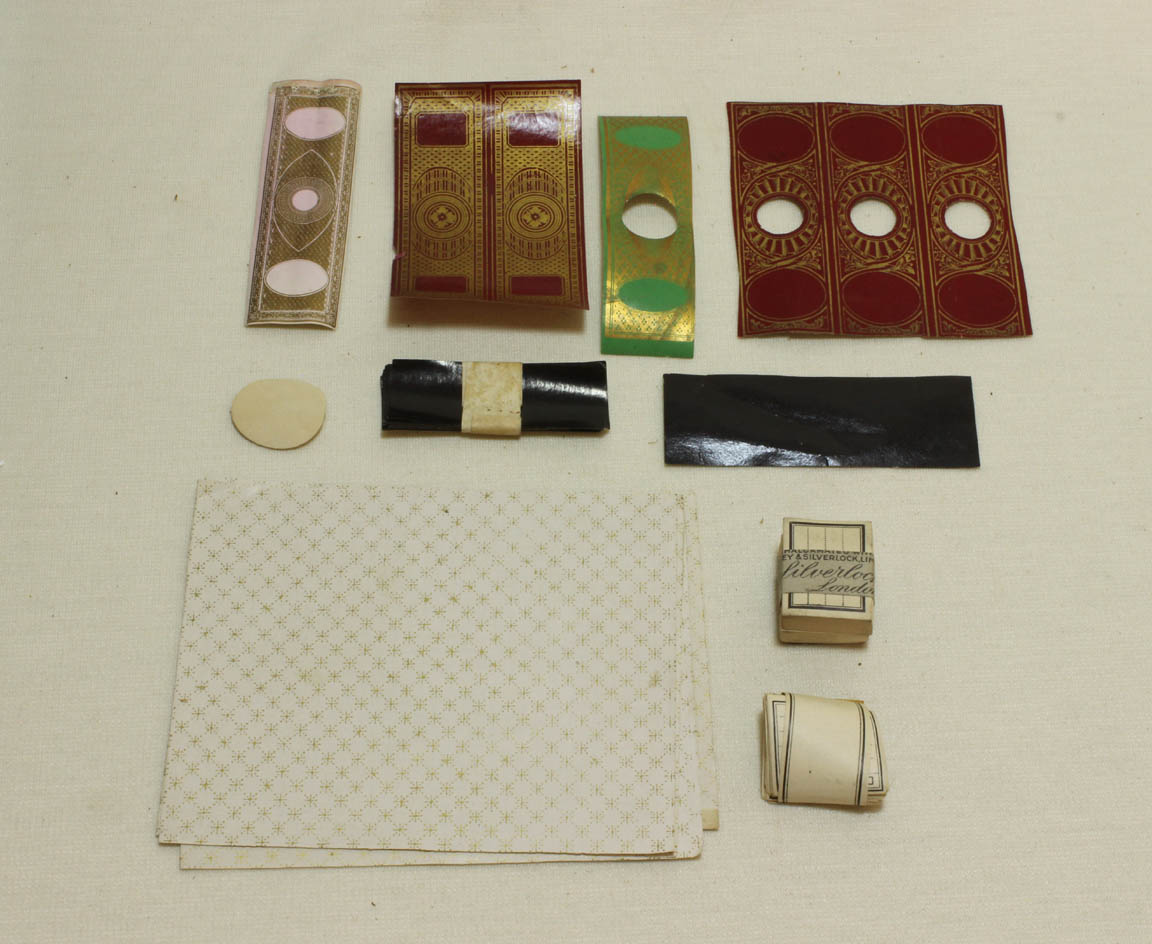
 Traditionally, slides of the second
half of the 19th century were covered with fancy papers. The paper was
sometimes simply a sheet cut to size, or pre-made papers of a size
suitable for covering standard 1 x 3 inch slides. Blank covers suitable
for small slides are also present in this kit. Additionally, some sort
of label was needed to identify the specimen. The identifying labels
shown here, made by Sutley & Silverlock, are still in their
original packaging, and were made in the first quarter of the twentieth
century. The small oval blank white labels shown on the left are from
the late nineteenth through early 20th centuries.
Traditionally, slides of the second
half of the 19th century were covered with fancy papers. The paper was
sometimes simply a sheet cut to size, or pre-made papers of a size
suitable for covering standard 1 x 3 inch slides. Blank covers suitable
for small slides are also present in this kit. Additionally, some sort
of label was needed to identify the specimen. The identifying labels
shown here, made by Sutley & Silverlock, are still in their
original packaging, and were made in the first quarter of the twentieth
century. The small oval blank white labels shown on the left are from
the late nineteenth through early 20th centuries.
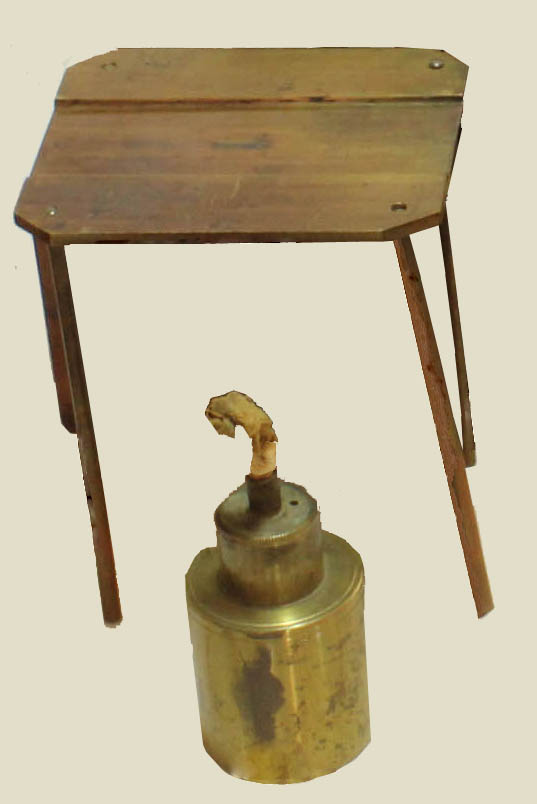 Once
a mountant was applied to a slide, it was often necessary to gently
heat the slide to rid the mountant of bubbles and/or soften the
mountant to flatten it and distribute it evenly over the specimen. For
this purpose a brass table with slot for a slide and a spirit lamp were
supplied. Early versions of this kit came with a glass lamp, but later
versions like this one had a brass lamp.
Once
a mountant was applied to a slide, it was often necessary to gently
heat the slide to rid the mountant of bubbles and/or soften the
mountant to flatten it and distribute it evenly over the specimen. For
this purpose a brass table with slot for a slide and a spirit lamp were
supplied. Early versions of this kit came with a glass lamp, but later
versions like this one had a brass lamp.
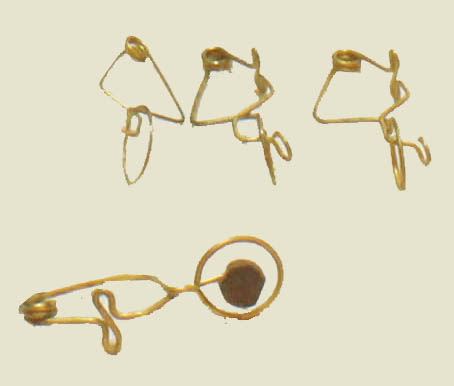 Some kind
of clamp was needed once a coverslip was applied over a mountant, to
hold it flat and prevent movement while the mountant dried. Supplied
with this kit were brass 'clips' for this purpose. The clips had cork
fittings to protect the cover slip from scratching or breaking.
Some kind
of clamp was needed once a coverslip was applied over a mountant, to
hold it flat and prevent movement while the mountant dried. Supplied
with this kit were brass 'clips' for this purpose. The clips had cork
fittings to protect the cover slip from scratching or breaking.
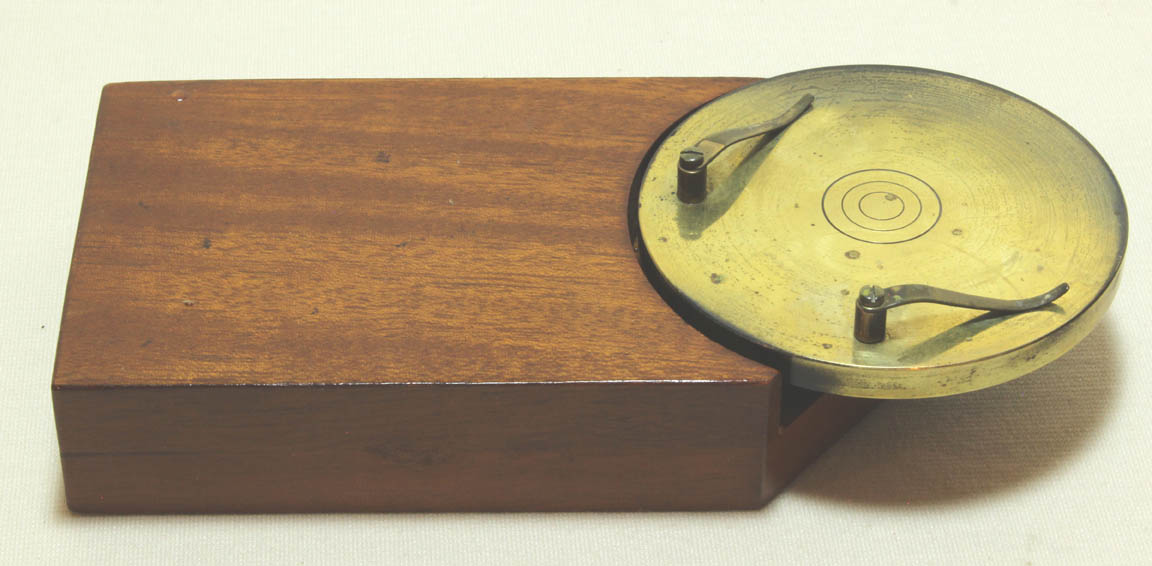 Once a
coverslip was secured, either directly on the slide or on top of a
cell, it was often sealed with a ringing compound. If the coverslip and
cell were round, this was facilitated by the ringing table, also known
as a 'turntable', or 'whirling table.' This device allowed a neat
circle of sealant to be applied, and its calibrated rings allowed
accurate centering.
Once a
coverslip was secured, either directly on the slide or on top of a
cell, it was often sealed with a ringing compound. If the coverslip and
cell were round, this was facilitated by the ringing table, also known
as a 'turntable', or 'whirling table.' This device allowed a neat
circle of sealant to be applied, and its calibrated rings allowed
accurate centering.
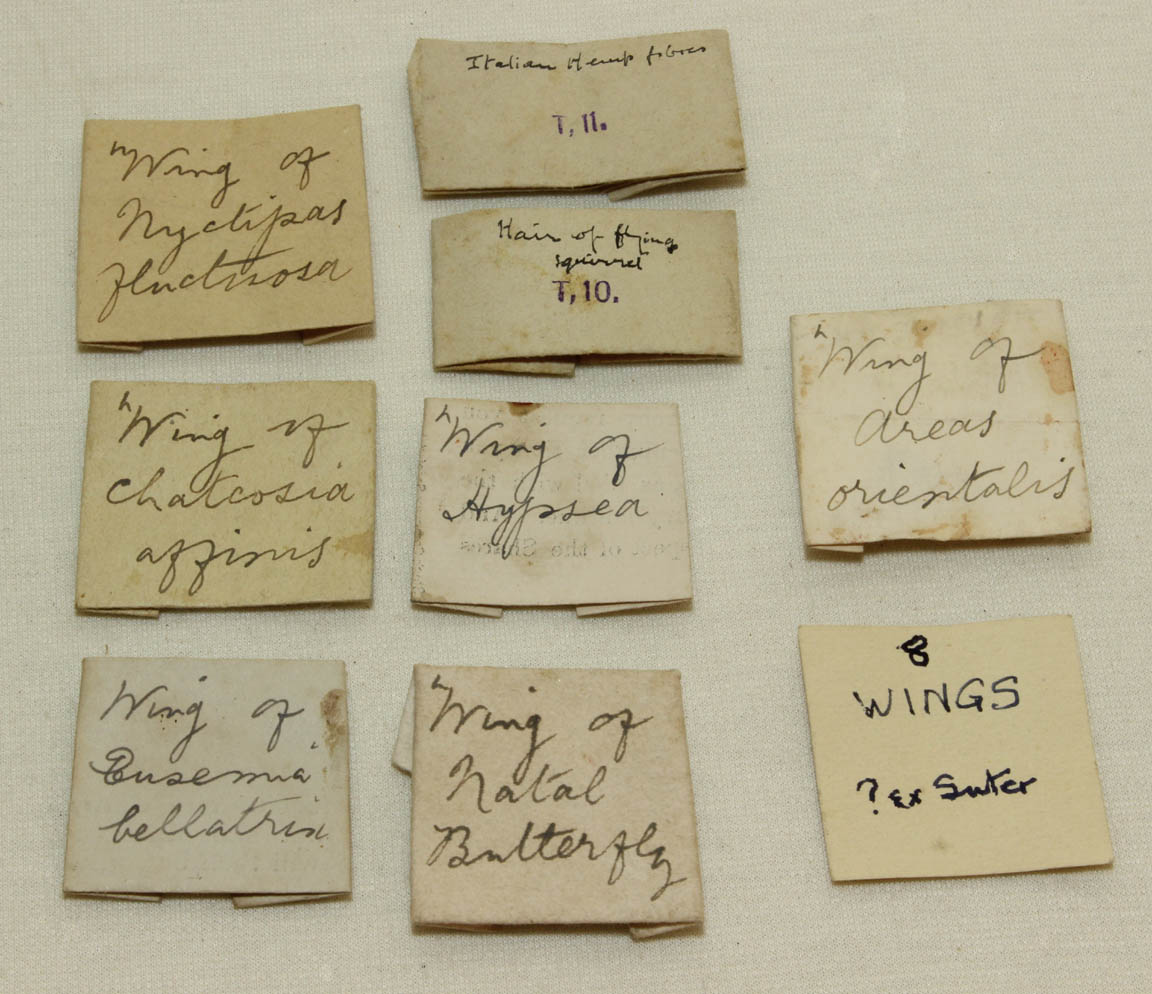
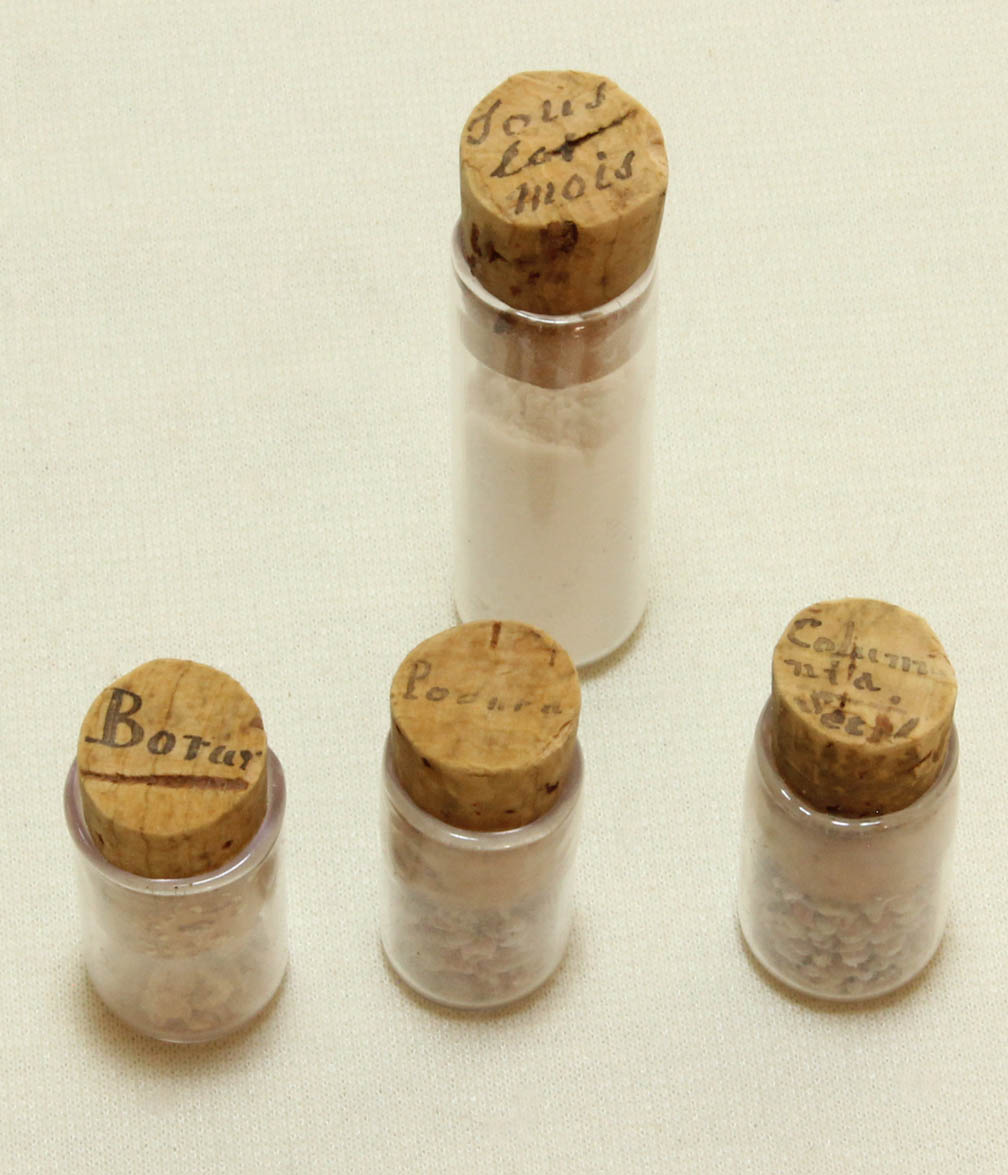 With this kit when I obtained it,
were a number unmounted specimens, folded inside neatly folded pieces
of paper, allowing the owner to mount them on his own. This is a
practice that dates back to the 1600's when Antony Van Leeuwenhoek
enclosed packages of specimens like this with his letters to the Royal
Society. Also with this kit were some vials of specimens, labeled on
their corks.
With this kit when I obtained it,
were a number unmounted specimens, folded inside neatly folded pieces
of paper, allowing the owner to mount them on his own. This is a
practice that dates back to the 1600's when Antony Van Leeuwenhoek
enclosed packages of specimens like this with his letters to the Royal
Society. Also with this kit were some vials of specimens, labeled on
their corks.
HISTORY:
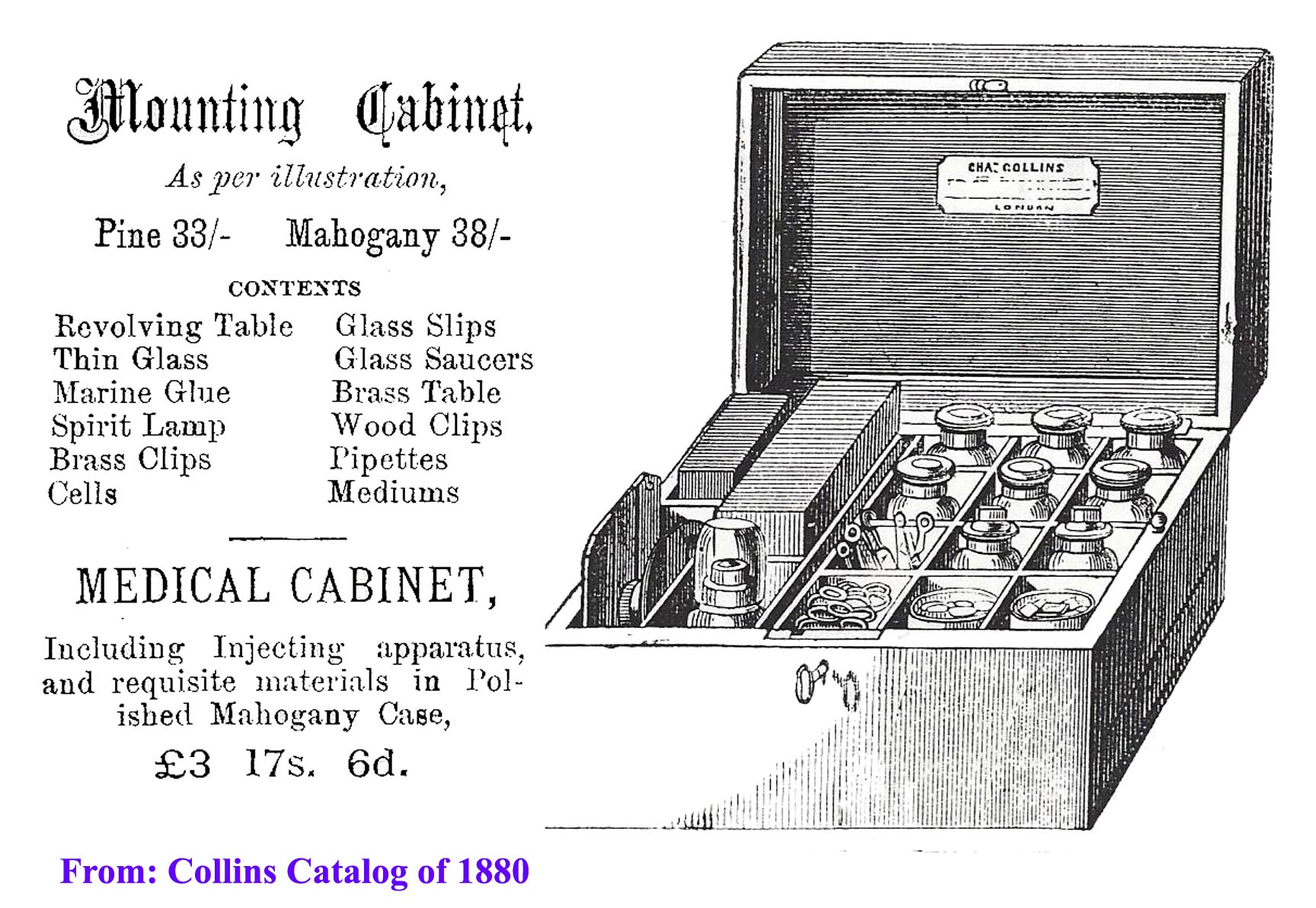 Among the first notices of this mounting kit was in the 1867 sixth
edition of 'The Microscope: Its History, Construction and
Application..' by Jabez Hogg, and in the Quarterly Journal of
Microscopical Science for the same year. It was listed as the 'Amateur
Mounting Cabinet' in the 1878 Collins Catalog and simply as the
'Mounting Cabinet' in the 1881 catalog. Examples exist both with
Collins' Great Portland Street Address, and also from his pre-1871
address on Great Titchfield Street. The earlier version came with a
glass Spirit Lamp, while later examples have the Brass lamp. Judging by
the number of surviving examples, this kit was quite popular. It was
frequently quoted as being of a more reasonable price than competing
examples by other sellers. For a detailed history of Collins, please
see Dr Brian Stevenson's site, Historical
Makers of Microscopes and Microscope Slides.
Among the first notices of this mounting kit was in the 1867 sixth
edition of 'The Microscope: Its History, Construction and
Application..' by Jabez Hogg, and in the Quarterly Journal of
Microscopical Science for the same year. It was listed as the 'Amateur
Mounting Cabinet' in the 1878 Collins Catalog and simply as the
'Mounting Cabinet' in the 1881 catalog. Examples exist both with
Collins' Great Portland Street Address, and also from his pre-1871
address on Great Titchfield Street. The earlier version came with a
glass Spirit Lamp, while later examples have the Brass lamp. Judging by
the number of surviving examples, this kit was quite popular. It was
frequently quoted as being of a more reasonable price than competing
examples by other sellers. For a detailed history of Collins, please
see Dr Brian Stevenson's site, Historical
Makers of Microscopes and Microscope Slides.
The author is grateful to James
Solliday, Brian Stevenson, and Joseph Zeligs for providing materials,
information and some of the illustrations used on this web page.
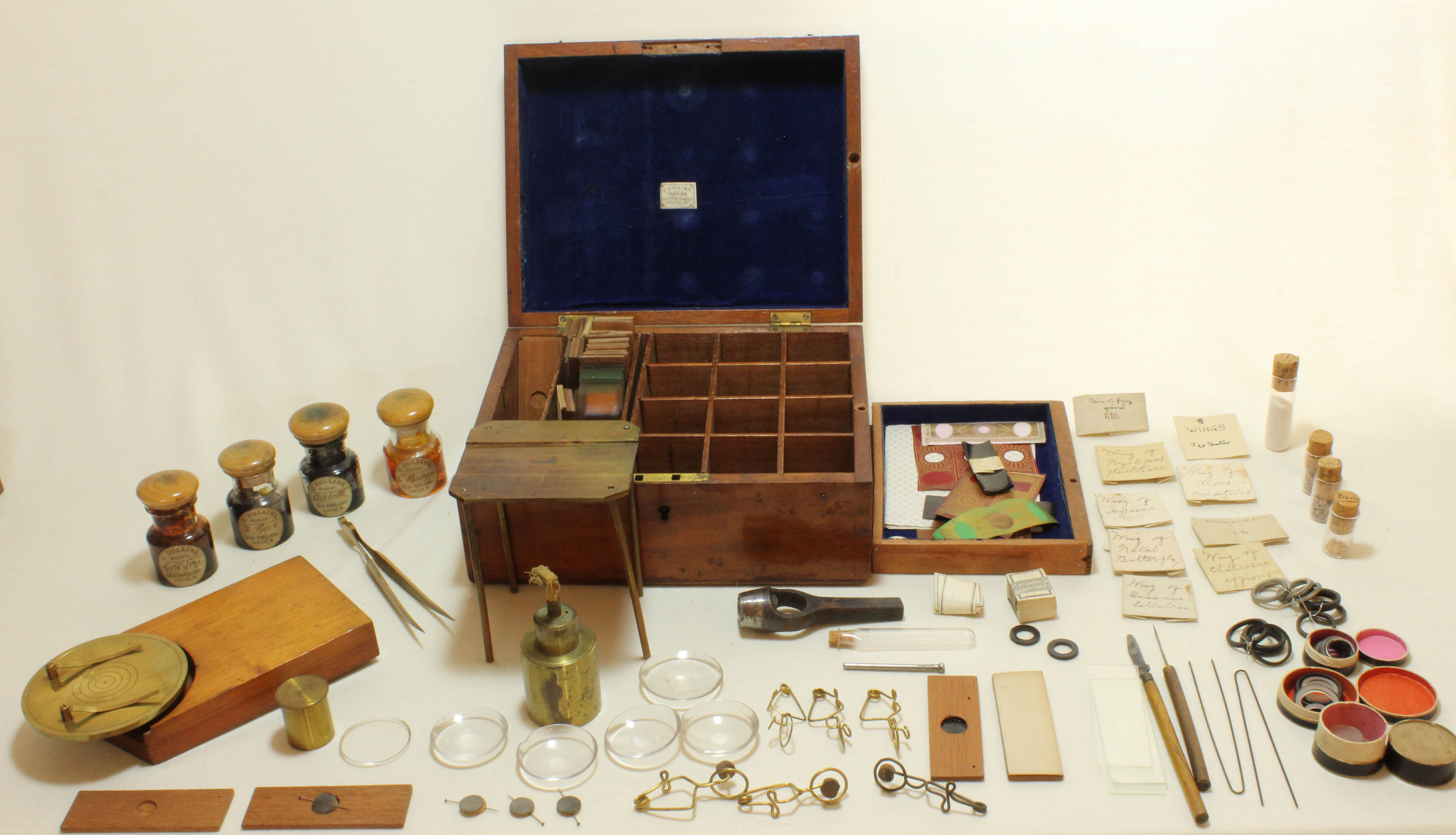

 This 'mounting cabinet' is made of
pine. The top lid is lined with blue velour and bears the small trade
label of 'Collins, Optician, 157 Gt PORTLAND ST, LONDON N.W.'
The contents are stored not only under the top lid, but also
in a drawer which slides out to the right side. This drawer is secured
by a pin from above and the drawer is held against the pin by some
tension imparted by some pieces of bent spring steel inside its
compartment. To release the drawer, one needs to push it inwards,
releasing some of the tension and allowing the pin to be withdrawn.
This 'mounting cabinet' is made of
pine. The top lid is lined with blue velour and bears the small trade
label of 'Collins, Optician, 157 Gt PORTLAND ST, LONDON N.W.'
The contents are stored not only under the top lid, but also
in a drawer which slides out to the right side. This drawer is secured
by a pin from above and the drawer is held against the pin by some
tension imparted by some pieces of bent spring steel inside its
compartment. To release the drawer, one needs to push it inwards,
releasing some of the tension and allowing the pin to be withdrawn.  Before
selecting a specimen for mounting (from pond water for example), small
portions of the source could be examined grossly on these
'watchglasses,' which Collins referred to as 'glass saucers.'
They came in a variety of sizes and depths and some had a
small portion of the bottom flattened to steady them on a table.
Before
selecting a specimen for mounting (from pond water for example), small
portions of the source could be examined grossly on these
'watchglasses,' which Collins referred to as 'glass saucers.'
They came in a variety of sizes and depths and some had a
small portion of the bottom flattened to steady them on a table.  The four bottles of
reagents, all with original Collins labels have wood-topped cork
stoppers. Canada Balsam, one of the best mountants of all time was of
course included. 'Asphalte' is a tar-like substance which was used for
sealing specimens under a coverslip and especially specimens in deep
cells and was used for 'ringing' the cell, a process facilitated by the
Ringing table. Goldsize is a material of a lighter color, used for the
same purpose as Asphalt, but being of lighter color could be used alone
or mixed with dies to impart color to the ring. Marine Glue, as its
name implies, is a water insoluble cement used for gluing a ring to a
slide and the coverslip to the ring. This glue will dry even in a moist
environment, allowing cells to contain liquid preservatives. Gold size
is another adhesive. (The author is grateful to James Solliday for the
information contained in this paragraph).
The four bottles of
reagents, all with original Collins labels have wood-topped cork
stoppers. Canada Balsam, one of the best mountants of all time was of
course included. 'Asphalte' is a tar-like substance which was used for
sealing specimens under a coverslip and especially specimens in deep
cells and was used for 'ringing' the cell, a process facilitated by the
Ringing table. Goldsize is a material of a lighter color, used for the
same purpose as Asphalt, but being of lighter color could be used alone
or mixed with dies to impart color to the ring. Marine Glue, as its
name implies, is a water insoluble cement used for gluing a ring to a
slide and the coverslip to the ring. This glue will dry even in a moist
environment, allowing cells to contain liquid preservatives. Gold size
is another adhesive. (The author is grateful to James Solliday for the
information contained in this paragraph).  A variety of sizes and depths of
'cells' were supplied with the kit. This allowed great flexibility in
mounting and protecting three dimensional specimens. They were made of
hard rubber, metal, and glass.
A variety of sizes and depths of
'cells' were supplied with the kit. This allowed great flexibility in
mounting and protecting three dimensional specimens. They were made of
hard rubber, metal, and glass.  Cork mounts were sometimes used to
hold opaque objects, especially three dimensional ones that did not
require sealing to protect them from the elements. Examples might
include small shells, minerals, and some crystals. These cork mounts
usually had a pin going through them. The specimen was mounted on one
side, with either a white or black background, the obverse often
labeled. These specimens could be stored one next to another, pinned to
a board. When examined, they fit inside a depression in a wooden slide,
This arrangement saved supplies and also space. The specimen could be
tilted on a special tilting superstage, to view its various three
dimensional characteristics. The big disadvantage was that the subject
was easily dislodged; many, if not most of the surviving examples have
lost their objects.
Cork mounts were sometimes used to
hold opaque objects, especially three dimensional ones that did not
require sealing to protect them from the elements. Examples might
include small shells, minerals, and some crystals. These cork mounts
usually had a pin going through them. The specimen was mounted on one
side, with either a white or black background, the obverse often
labeled. These specimens could be stored one next to another, pinned to
a board. When examined, they fit inside a depression in a wooden slide,
This arrangement saved supplies and also space. The specimen could be
tilted on a special tilting superstage, to view its various three
dimensional characteristics. The big disadvantage was that the subject
was easily dislodged; many, if not most of the surviving examples have
lost their objects. 
 According to the catalog, the kit
was supplied with standard (1 x 3 inch) glass slides and also wooden
ones. The glass slides of this period in history usually had polished
edges. Those of the early twentieth century actually took a step
backward and were often sold without polished edges. The wooden slides
supplied with this kit are also of standard size, and have round
cavities of various depths and diameters. They could be used to hold
cork mounts, or, with a suitable base layer of black or white paper,
solid objects of their own. These slides are made of mahogany.
According to the catalog, the kit
was supplied with standard (1 x 3 inch) glass slides and also wooden
ones. The glass slides of this period in history usually had polished
edges. Those of the early twentieth century actually took a step
backward and were often sold without polished edges. The wooden slides
supplied with this kit are also of standard size, and have round
cavities of various depths and diameters. They could be used to hold
cork mounts, or, with a suitable base layer of black or white paper,
solid objects of their own. These slides are made of mahogany.  According
to the catalog both round and square cover slips were supplied with
this kit. At that time in history (2nd half of 19th C), these were
usually supplied in little round cardboard boxes, usually with black
sides and white tops; sometimes the tops were labeled. The inside of
the boxes of this period were usually colored pink or red.
According
to the catalog both round and square cover slips were supplied with
this kit. At that time in history (2nd half of 19th C), these were
usually supplied in little round cardboard boxes, usually with black
sides and white tops; sometimes the tops were labeled. The inside of
the boxes of this period were usually colored pink or red. 
 Traditionally, slides of the second
half of the 19th century were covered with fancy papers. The paper was
sometimes simply a sheet cut to size, or pre-made papers of a size
suitable for covering standard 1 x 3 inch slides. Blank covers suitable
for small slides are also present in this kit. Additionally, some sort
of label was needed to identify the specimen. The identifying labels
shown here, made by Sutley & Silverlock, are still in their
original packaging, and were made in the first quarter of the twentieth
century. The small oval blank white labels shown on the left are from
the late nineteenth through early 20th centuries.
Traditionally, slides of the second
half of the 19th century were covered with fancy papers. The paper was
sometimes simply a sheet cut to size, or pre-made papers of a size
suitable for covering standard 1 x 3 inch slides. Blank covers suitable
for small slides are also present in this kit. Additionally, some sort
of label was needed to identify the specimen. The identifying labels
shown here, made by Sutley & Silverlock, are still in their
original packaging, and were made in the first quarter of the twentieth
century. The small oval blank white labels shown on the left are from
the late nineteenth through early 20th centuries.  Once
a mountant was applied to a slide, it was often necessary to gently
heat the slide to rid the mountant of bubbles and/or soften the
mountant to flatten it and distribute it evenly over the specimen. For
this purpose a brass table with slot for a slide and a spirit lamp were
supplied. Early versions of this kit came with a glass lamp, but later
versions like this one had a brass lamp.
Once
a mountant was applied to a slide, it was often necessary to gently
heat the slide to rid the mountant of bubbles and/or soften the
mountant to flatten it and distribute it evenly over the specimen. For
this purpose a brass table with slot for a slide and a spirit lamp were
supplied. Early versions of this kit came with a glass lamp, but later
versions like this one had a brass lamp.  Some kind
of clamp was needed once a coverslip was applied over a mountant, to
hold it flat and prevent movement while the mountant dried. Supplied
with this kit were brass 'clips' for this purpose. The clips had cork
fittings to protect the cover slip from scratching or breaking.
Some kind
of clamp was needed once a coverslip was applied over a mountant, to
hold it flat and prevent movement while the mountant dried. Supplied
with this kit were brass 'clips' for this purpose. The clips had cork
fittings to protect the cover slip from scratching or breaking.  Once a
coverslip was secured, either directly on the slide or on top of a
cell, it was often sealed with a ringing compound. If the coverslip and
cell were round, this was facilitated by the ringing table, also known
as a 'turntable', or 'whirling table.' This device allowed a neat
circle of sealant to be applied, and its calibrated rings allowed
accurate centering.
Once a
coverslip was secured, either directly on the slide or on top of a
cell, it was often sealed with a ringing compound. If the coverslip and
cell were round, this was facilitated by the ringing table, also known
as a 'turntable', or 'whirling table.' This device allowed a neat
circle of sealant to be applied, and its calibrated rings allowed
accurate centering. 
 With this kit when I obtained it,
were a number unmounted specimens, folded inside neatly folded pieces
of paper, allowing the owner to mount them on his own. This is a
practice that dates back to the 1600's when Antony Van Leeuwenhoek
enclosed packages of specimens like this with his letters to the Royal
Society. Also with this kit were some vials of specimens, labeled on
their corks.
With this kit when I obtained it,
were a number unmounted specimens, folded inside neatly folded pieces
of paper, allowing the owner to mount them on his own. This is a
practice that dates back to the 1600's when Antony Van Leeuwenhoek
enclosed packages of specimens like this with his letters to the Royal
Society. Also with this kit were some vials of specimens, labeled on
their corks.  Among the first notices of this mounting kit was in the 1867 sixth
edition of 'The Microscope: Its History, Construction and
Application..' by Jabez Hogg, and in the Quarterly Journal of
Microscopical Science for the same year. It was listed as the 'Amateur
Mounting Cabinet' in the 1878 Collins Catalog and simply as the
'Mounting Cabinet' in the 1881 catalog. Examples exist both with
Collins' Great Portland Street Address, and also from his pre-1871
address on Great Titchfield Street. The earlier version came with a
glass Spirit Lamp, while later examples have the Brass lamp. Judging by
the number of surviving examples, this kit was quite popular. It was
frequently quoted as being of a more reasonable price than competing
examples by other sellers. For a detailed history of Collins, please
see Dr Brian Stevenson's site, Historical
Makers of Microscopes and Microscope Slides.
Among the first notices of this mounting kit was in the 1867 sixth
edition of 'The Microscope: Its History, Construction and
Application..' by Jabez Hogg, and in the Quarterly Journal of
Microscopical Science for the same year. It was listed as the 'Amateur
Mounting Cabinet' in the 1878 Collins Catalog and simply as the
'Mounting Cabinet' in the 1881 catalog. Examples exist both with
Collins' Great Portland Street Address, and also from his pre-1871
address on Great Titchfield Street. The earlier version came with a
glass Spirit Lamp, while later examples have the Brass lamp. Judging by
the number of surviving examples, this kit was quite popular. It was
frequently quoted as being of a more reasonable price than competing
examples by other sellers. For a detailed history of Collins, please
see Dr Brian Stevenson's site, Historical
Makers of Microscopes and Microscope Slides.